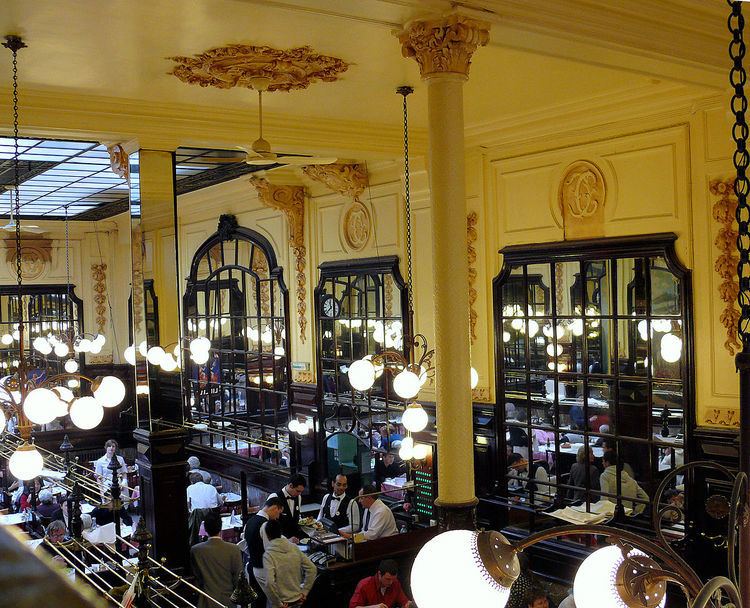 | ||
In France, a bouillon (French: bouillir, English: to boil) is a traditional (late 19th or early 20th century), spacious restaurant that usually serves traditional French cuisine, in particular a Bouillon (broth) which has provided the name for this class of restaurants.
Contents
When invented, the concept was to serve good quality food fast and at affordable prices. And in more than a century, not much has changed.
Today, the buildings of some bouillons are listed historical monuments.
History
The first bouillons appeared in 1855 thanks to an astute butcher, Pierre Louis Duval. He proposed a single dish of meat and a bouillon (soup/stock) to the workers of the market halls. In 1900, nearly two hundred and fifty bouillons could be found in Paris. They became the first popular chain of restaurants. Some other bouillons, more "upper-class", offered a reading room or some entertainment.
Meanwhile, the charm of Art Nouveau spread through Europe, in architecture, furniture and decoration. The various World's Fairs in Paris 1878, 1889, and 1900, accelerated its influence and the restaurants followed the trend.
In 1903, the first Bouillon Gandon-Duval opened in an old restaurant converted by the owner and architect Edouard Fournier.
In 1904, another bouillon with a luxurious Art Nouveau decoration was opened on Boulevard Saint-Germain. The architect was Jean-Marie Bouvier. Today, it accommodates the restaurant "Le Vagende" which is no bouillon.
It was with Louis Trezel that Edouard Chartier opened two further Bouillons Chartier in 1906: the Grand Bouillon Camille Chartier on Racine Street and the Bouillon Edouard Chartier on Montparnasse Boulevard. These restaurants showed the so characteristic Art Nouveau style : carved wood and ceramics, with mirrors and glass paintings.
Nowadays, only a few authentic bouillons remain, such as the one of the Faubourg-Montmartre and in particular the one in Racine Street which has the most baroque style of Art Nouveau.
Until 1926, Camille Chartier remained the owner of the place. After being called Bouillon Ollé and Joussot, it was Mrs Launois who kept the restaurant until 1956. The following purchaser sold the goodwill to the University of Paris which opened there a restaurant for the staff of the Sorbonne from 1962 until 1993. The major part of the decoration survived but the restaurant did not benefit from the special care allotted to luxurious restaurants.
The complete renovation of the Bouillon Racine took place in 1996 thanks to the Compagnons du Tour de France. It then called upon old expertise of almost lost techniques and skills. Bevelled mirrors, painted opalines, stained glass, carved woodworks, marble mosaics and gold-leaf lettering provide the public with the pleasure of a rich place, as much by its beauty as by its conviviality. It was subsequently classified as an Historic Building.
